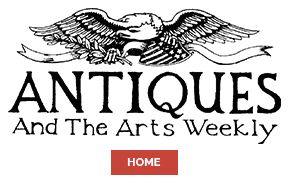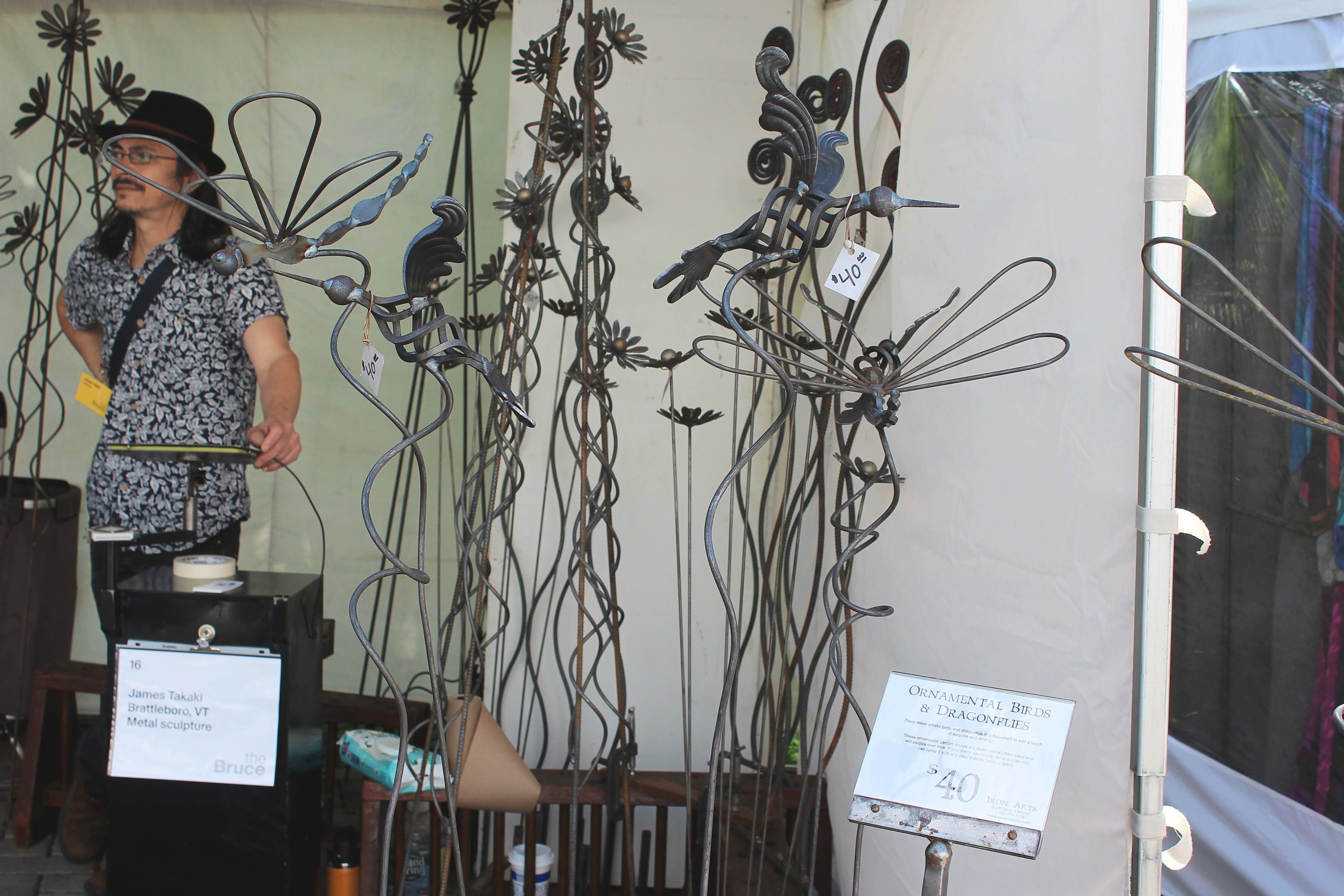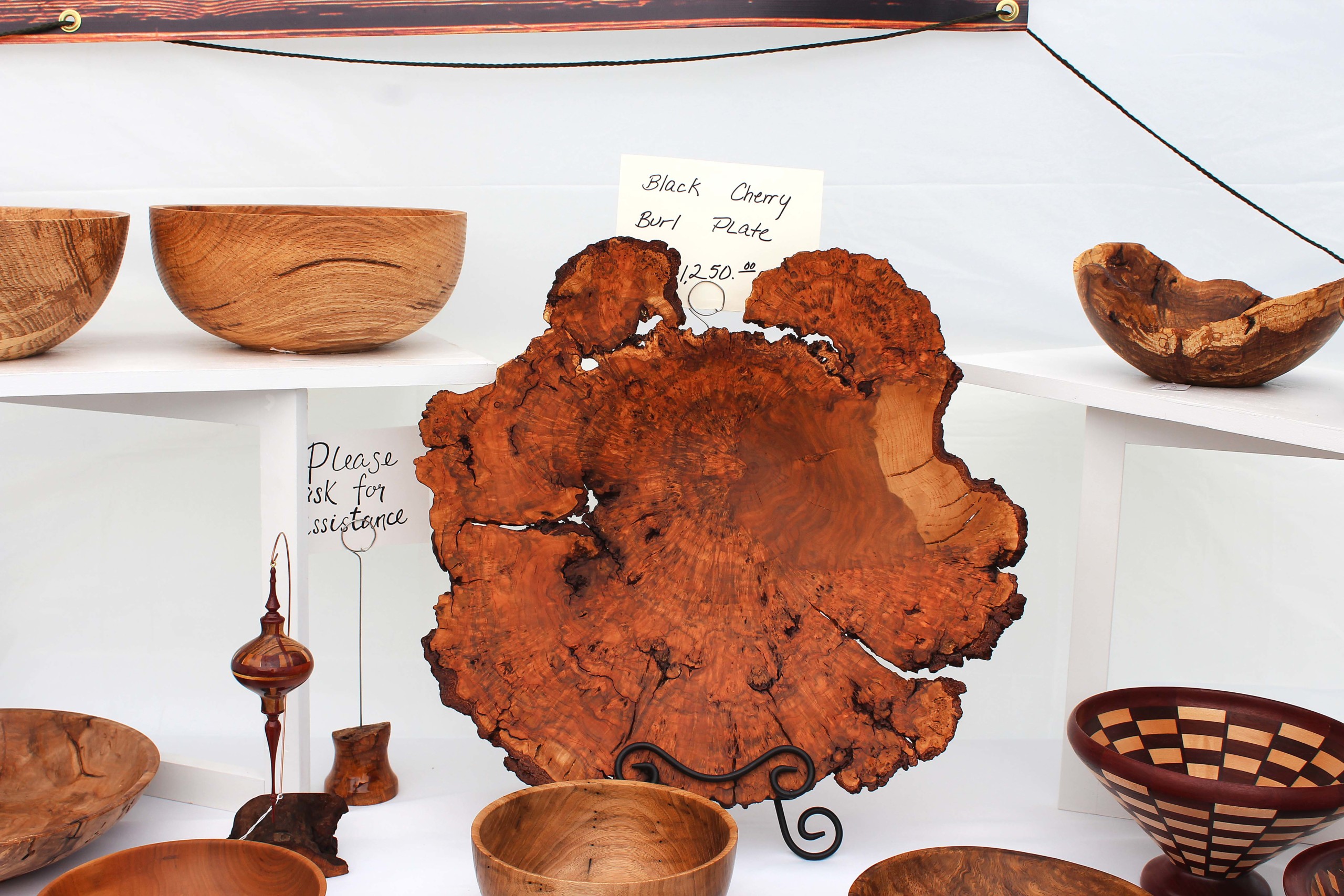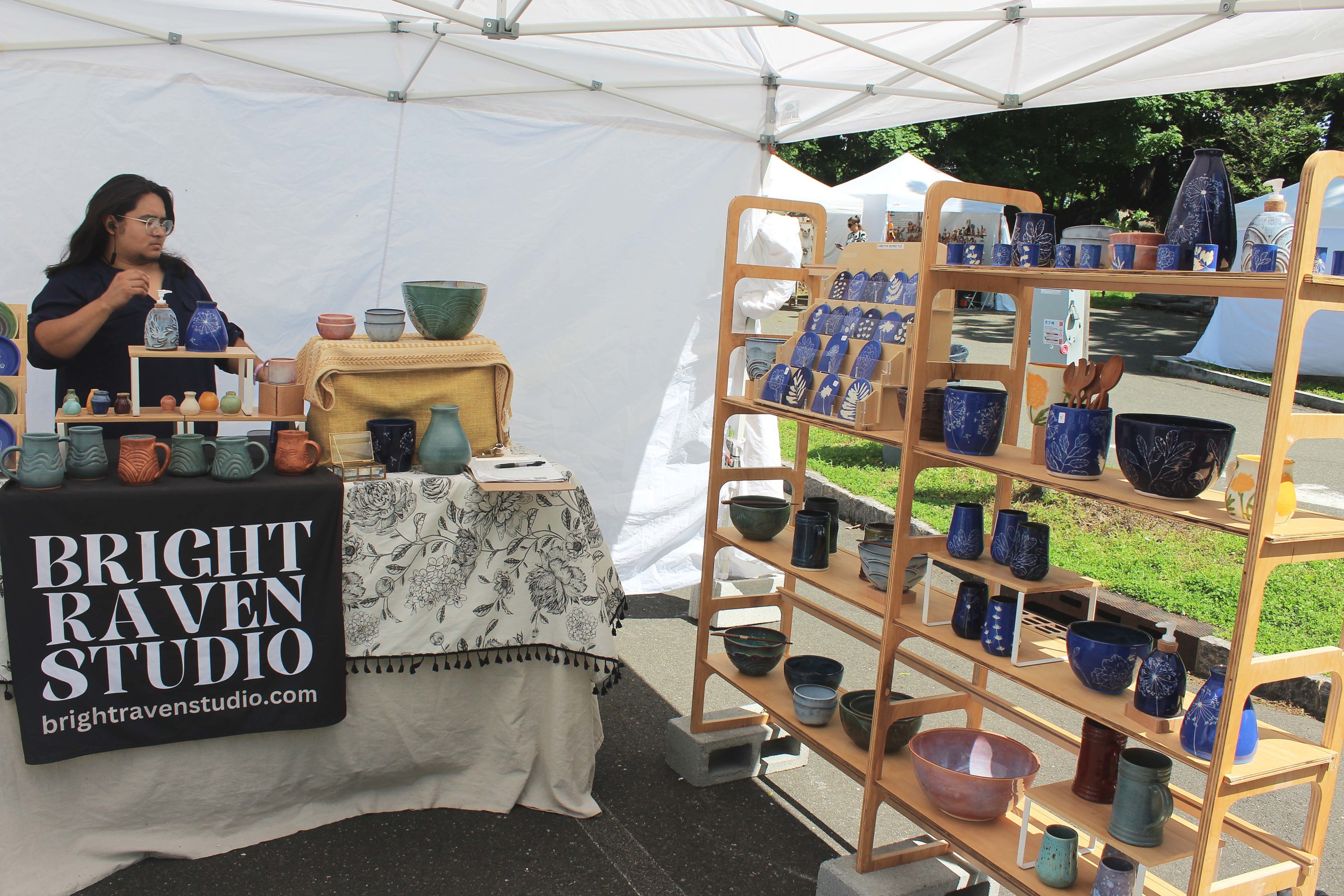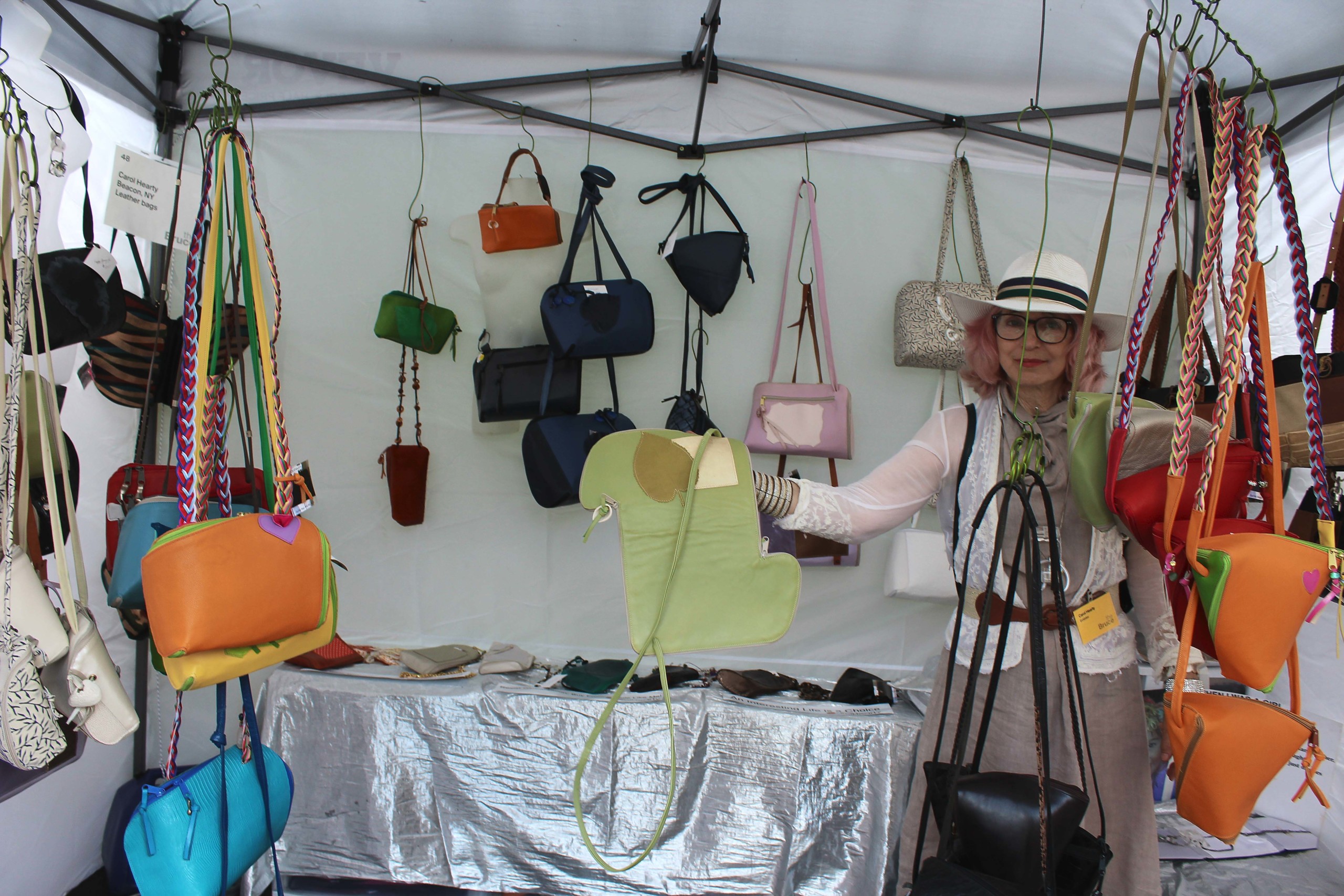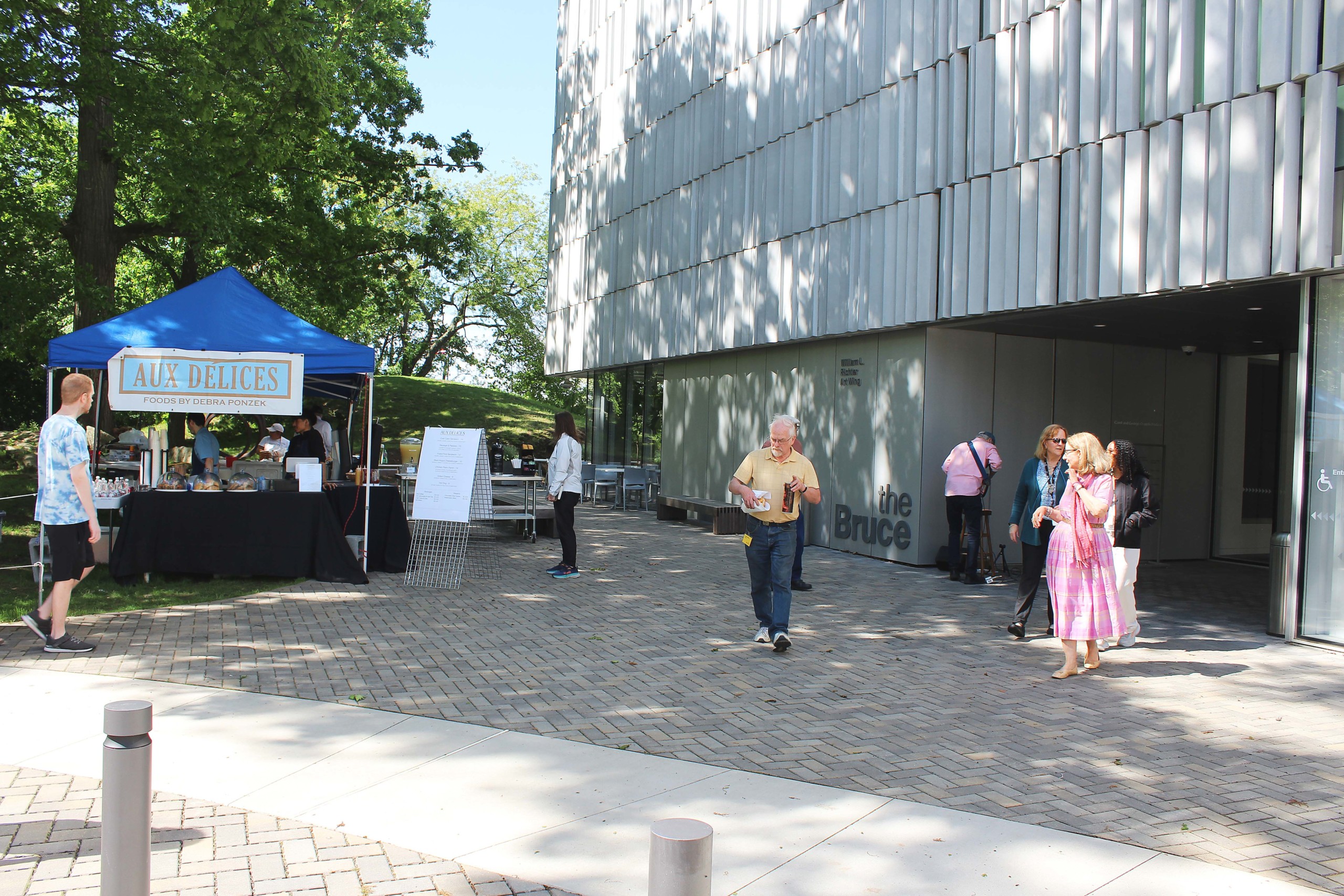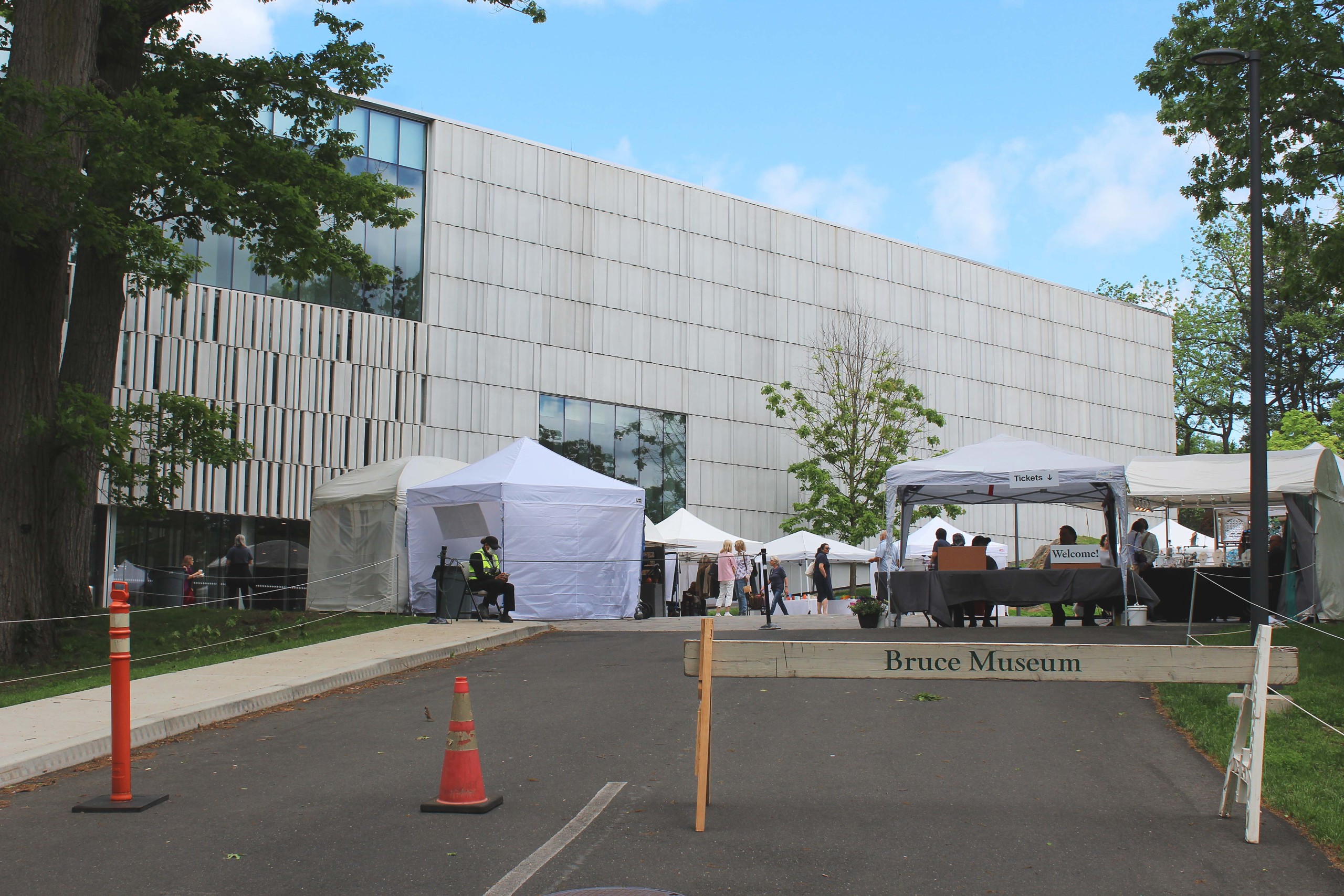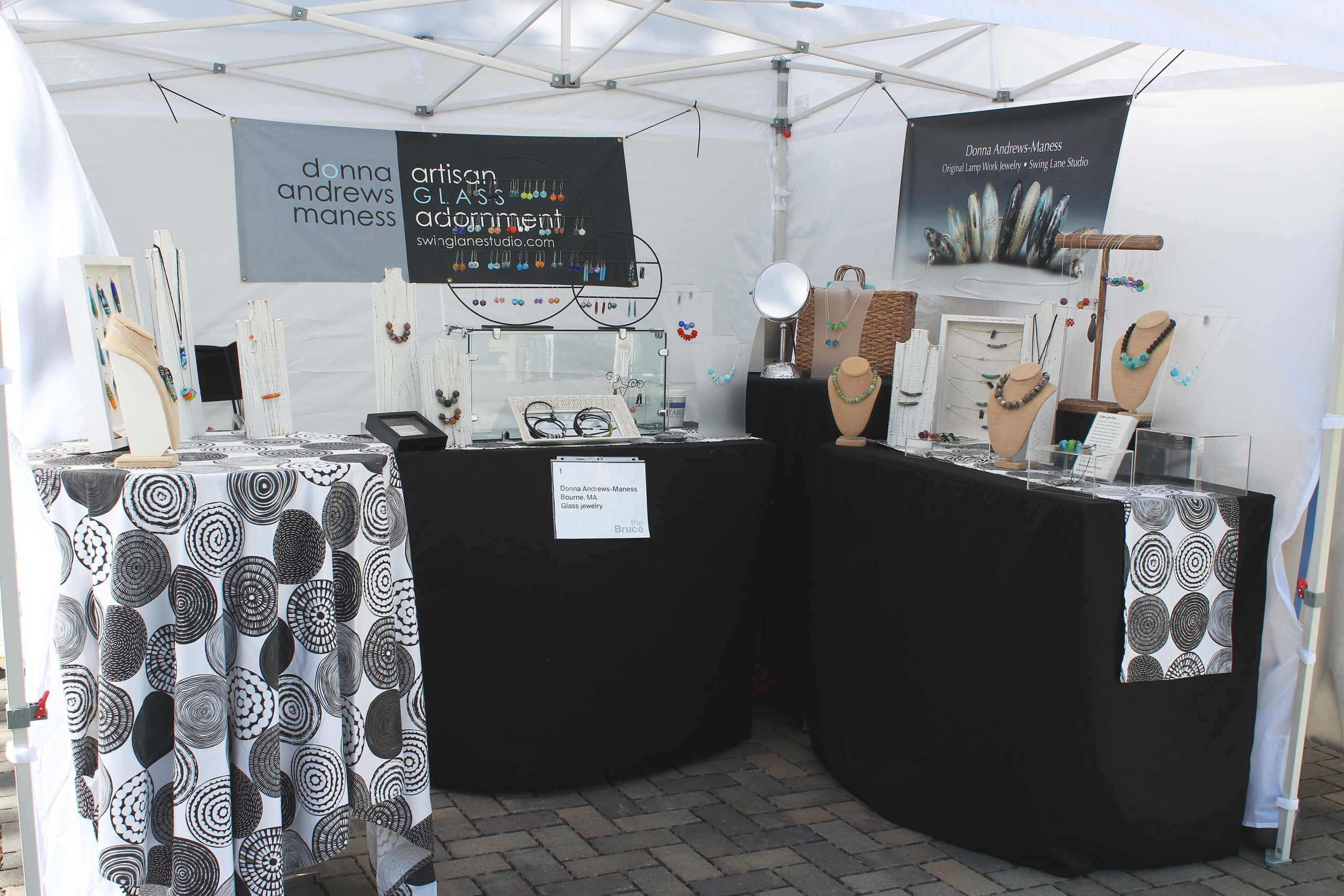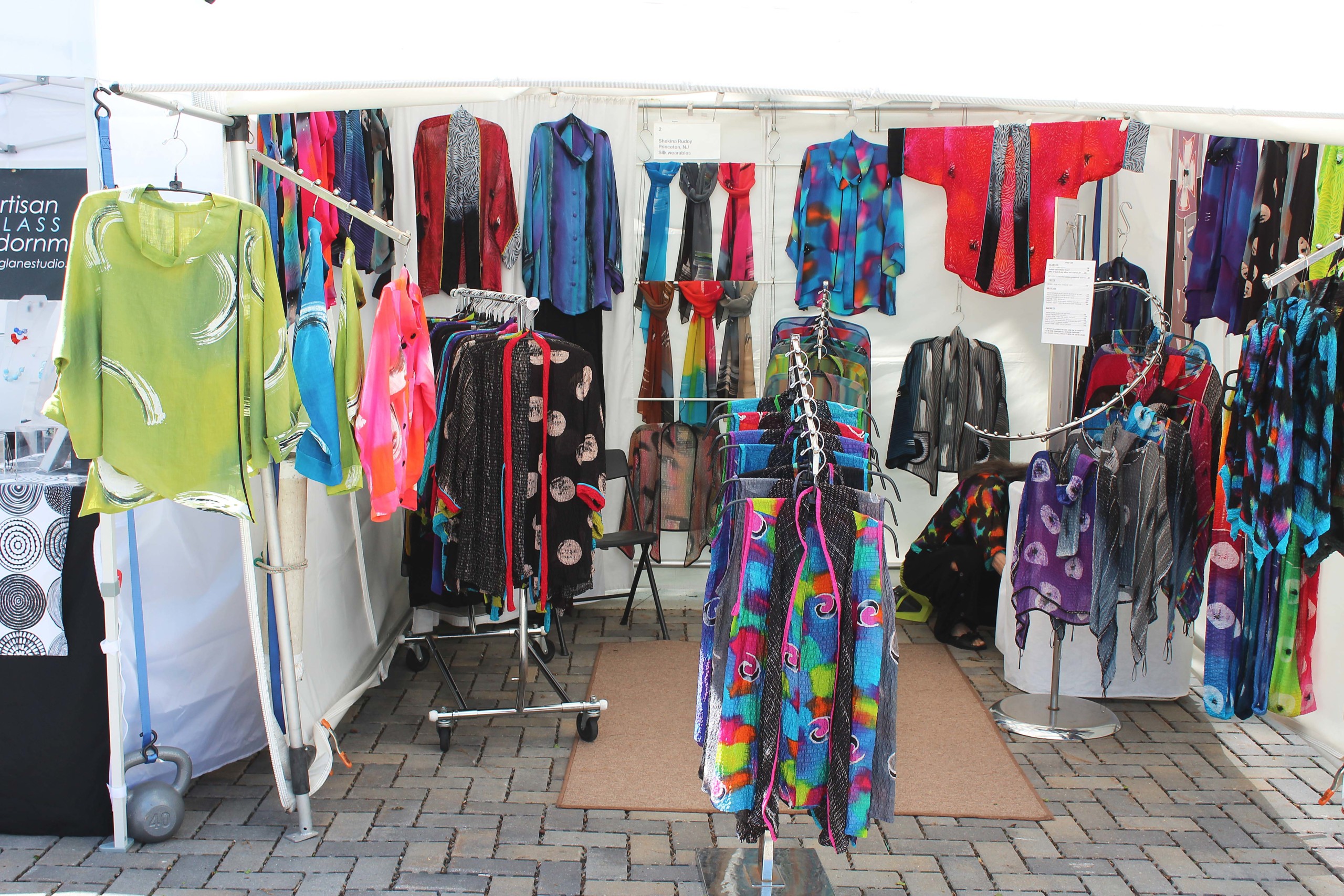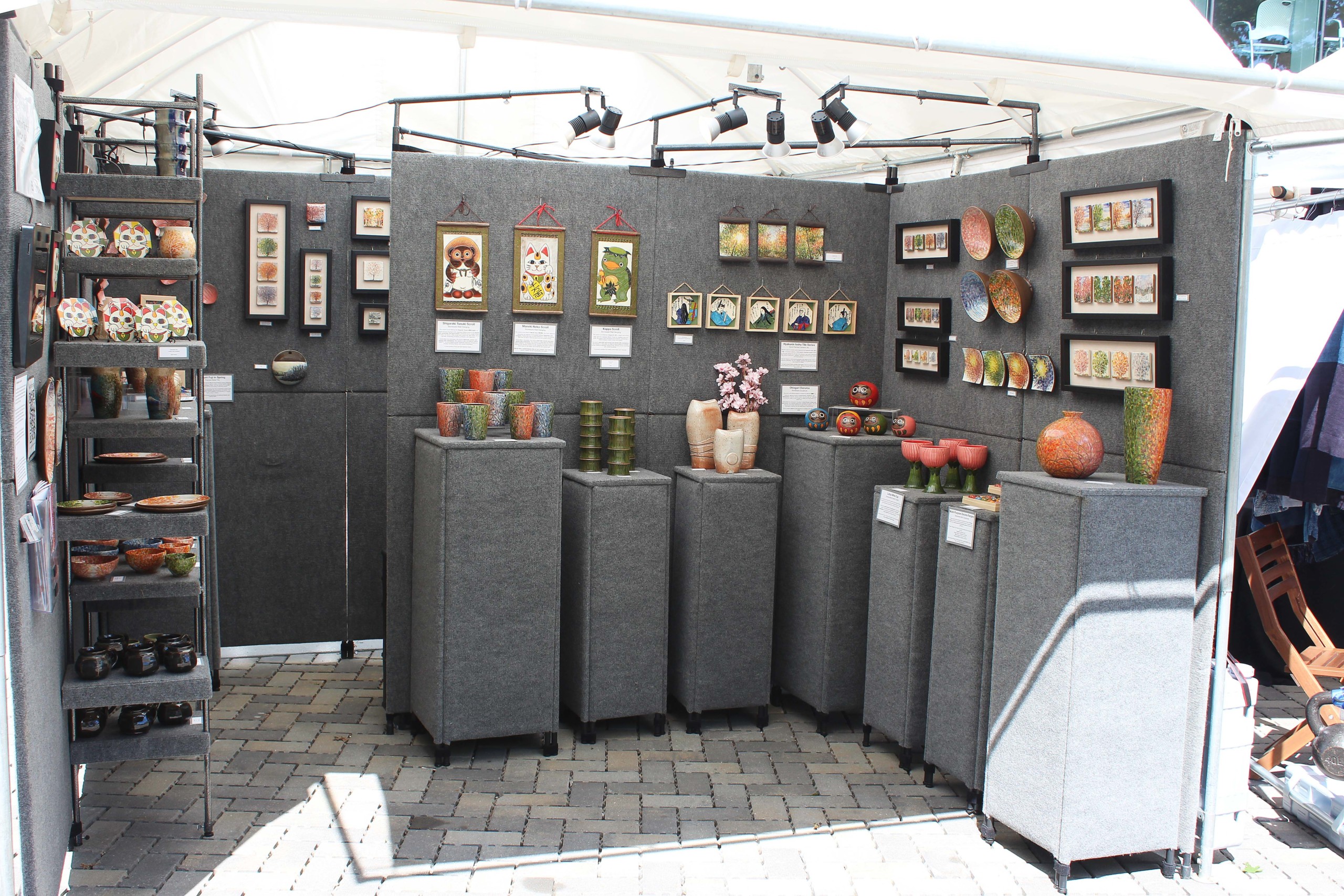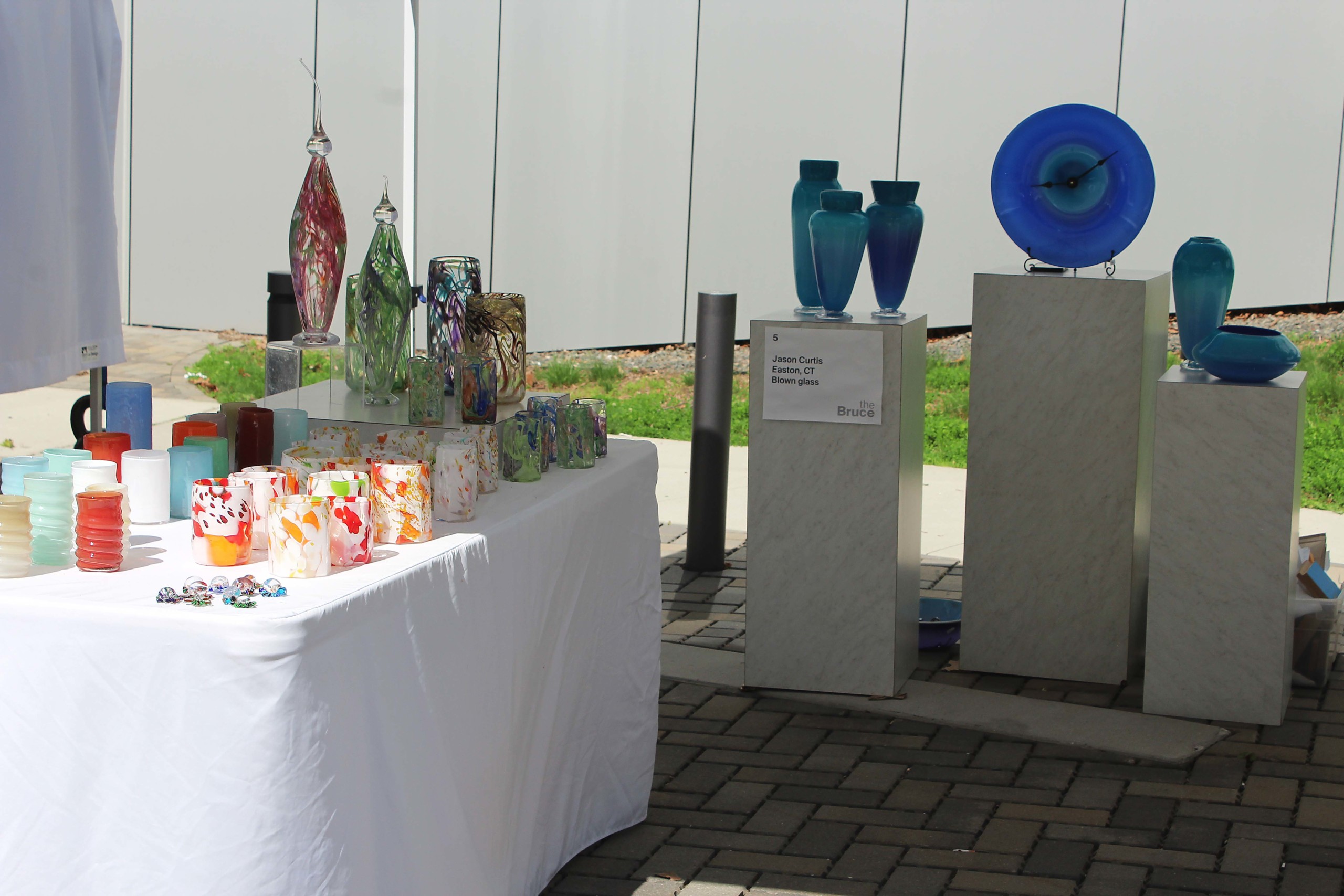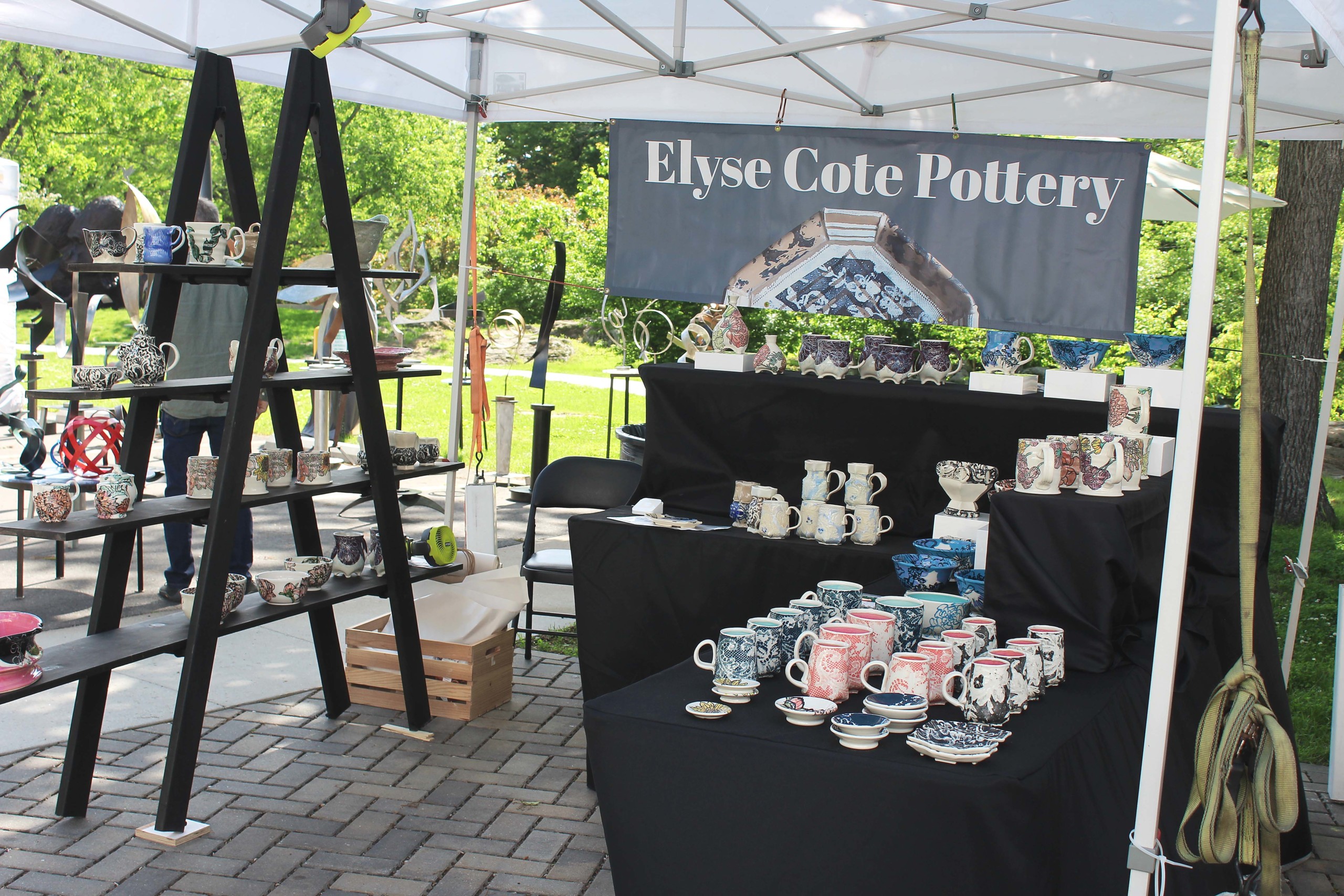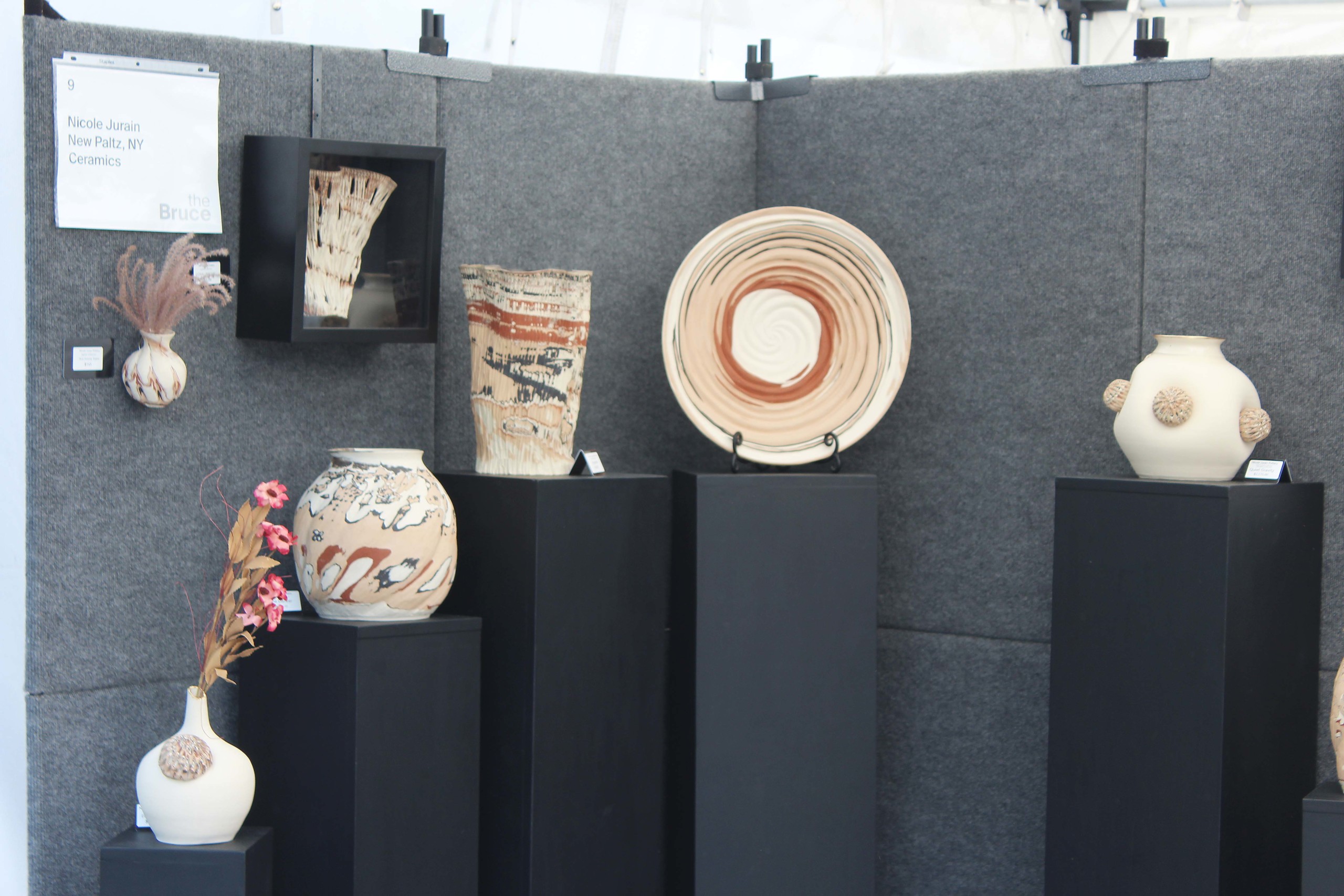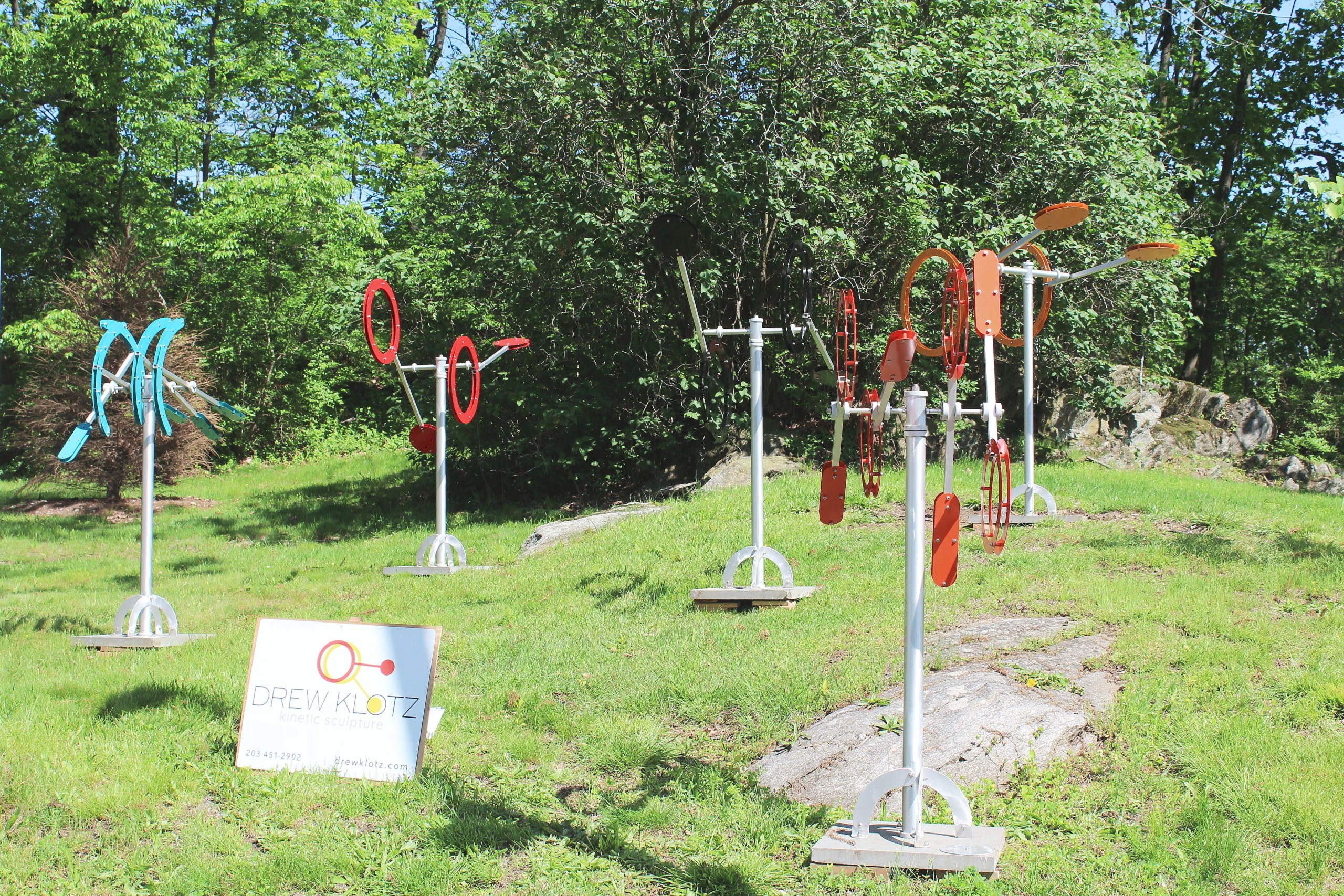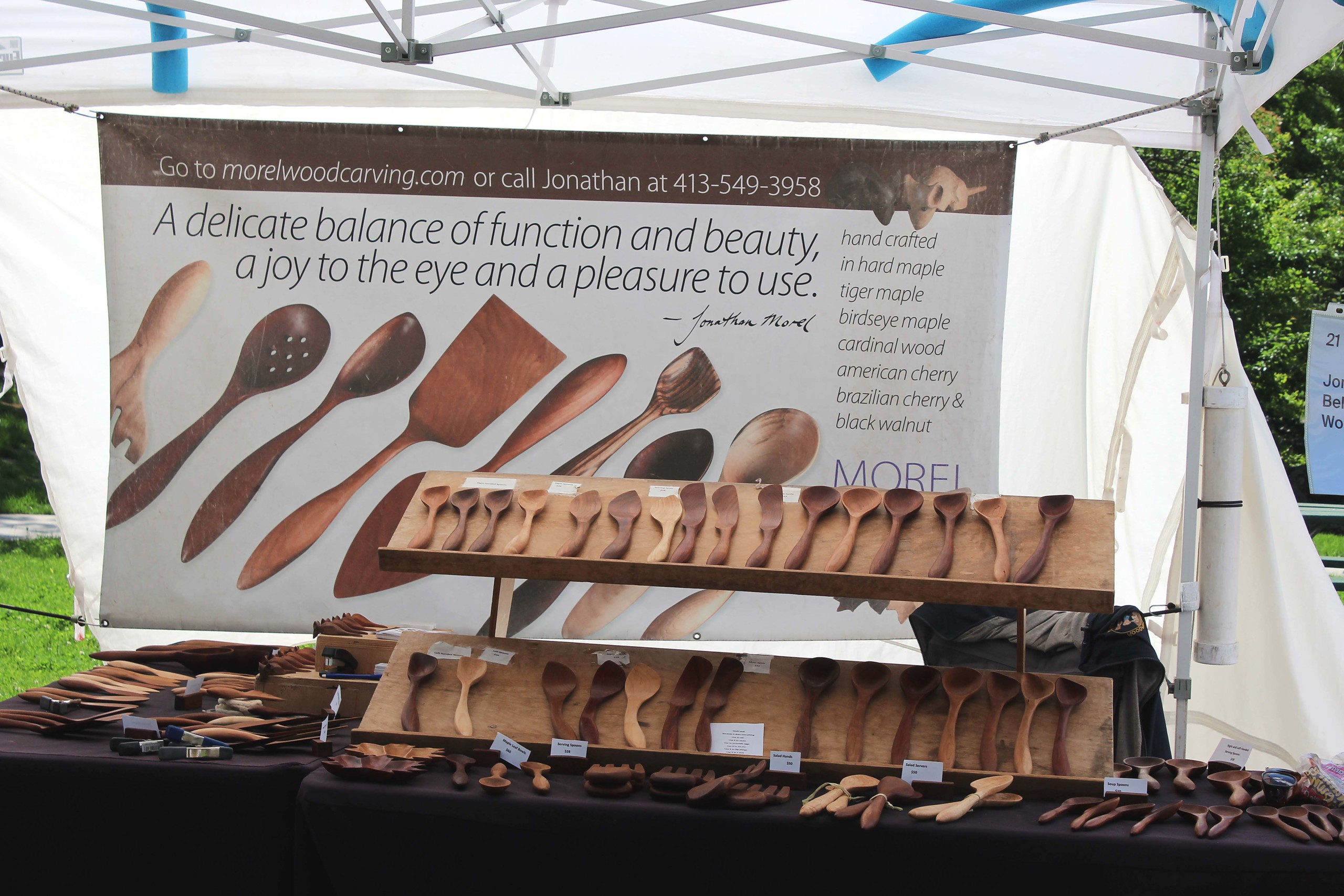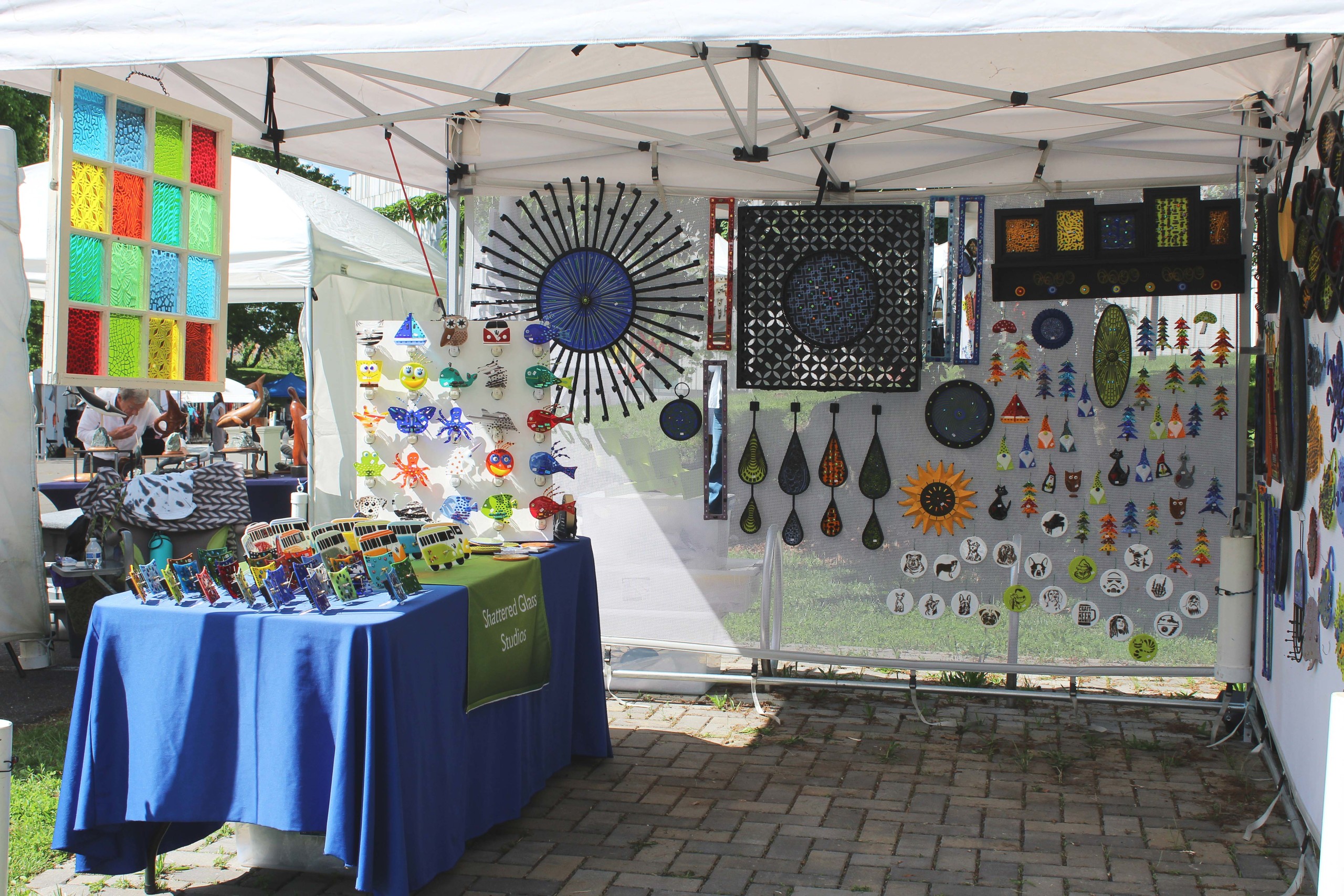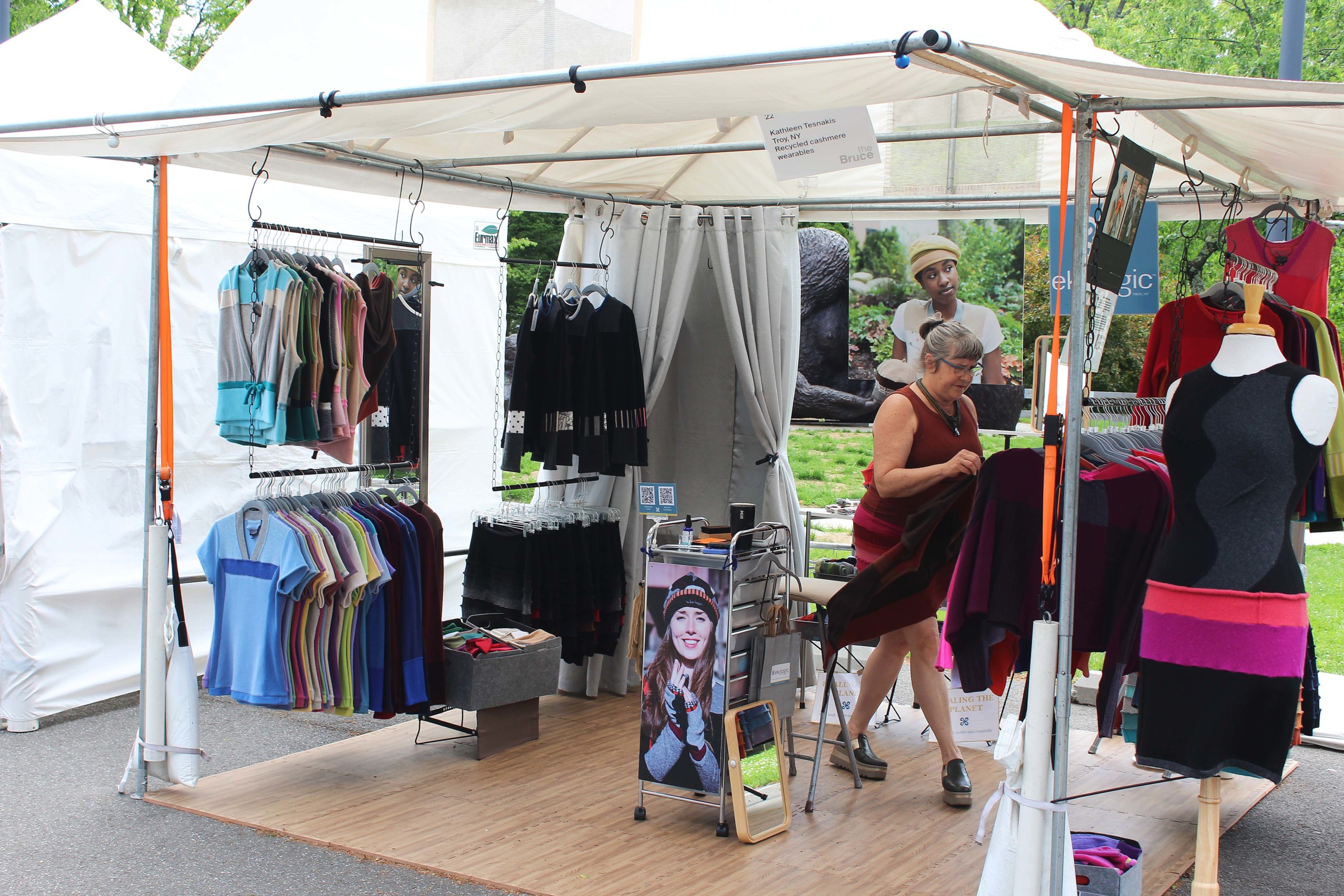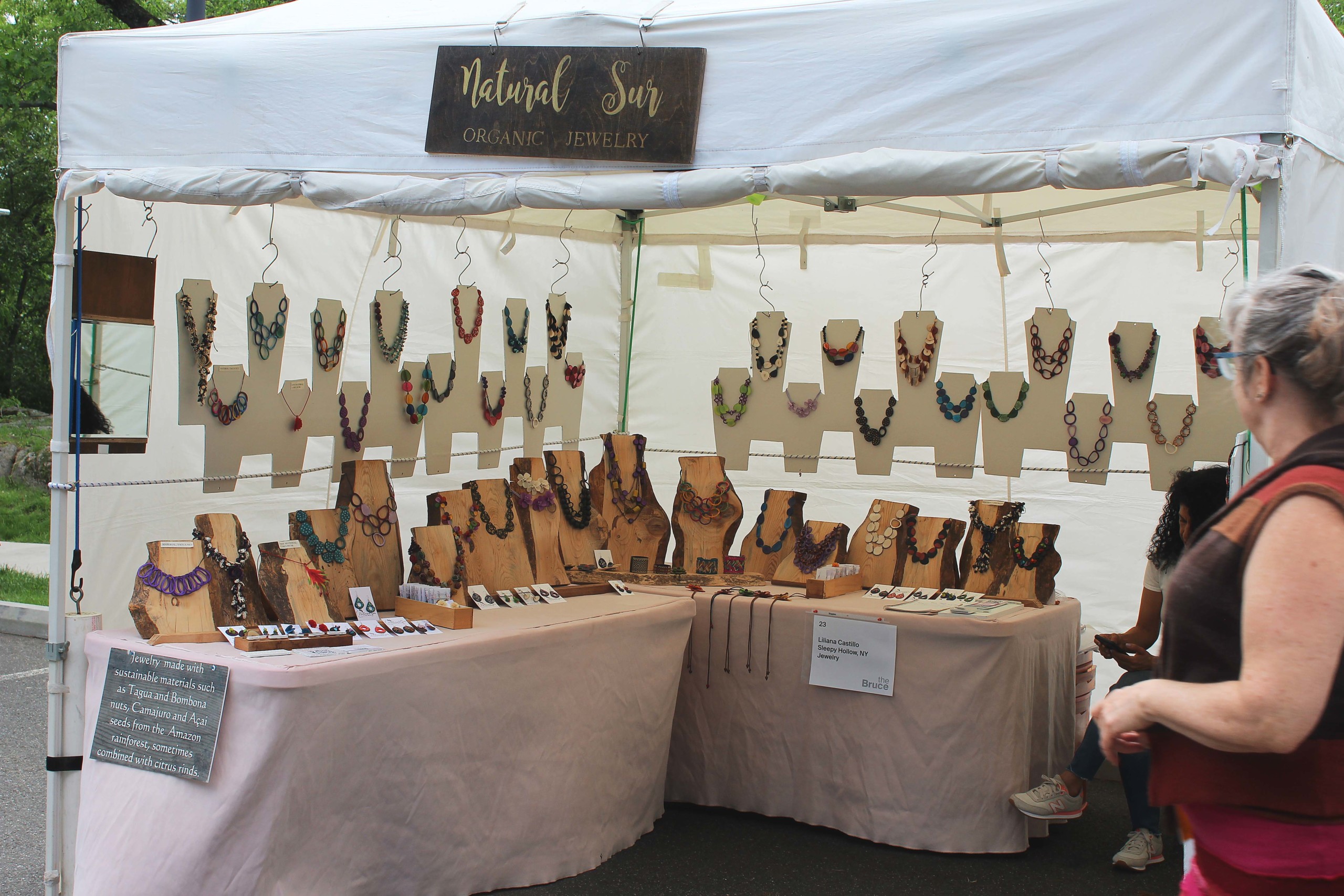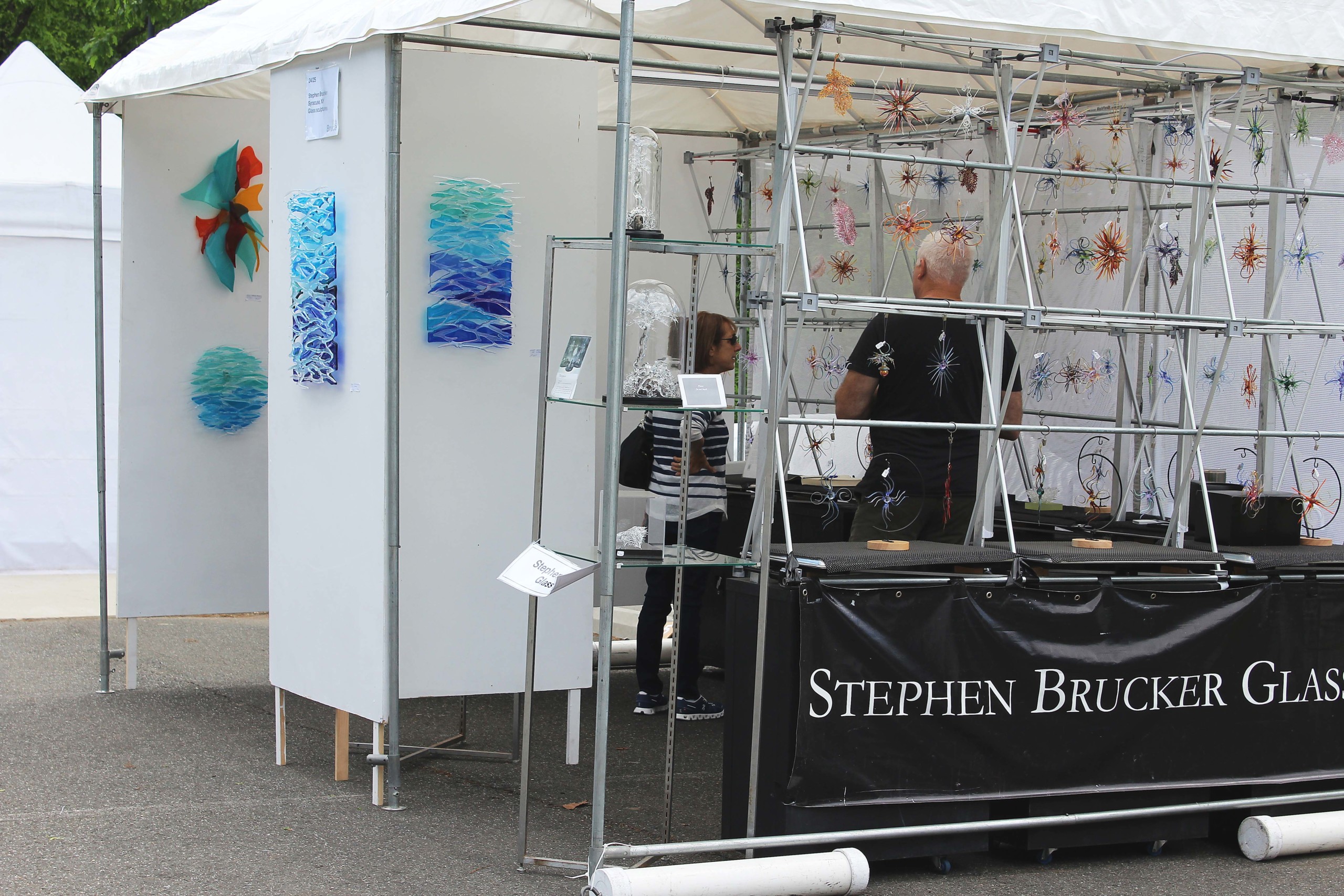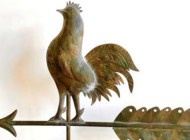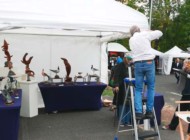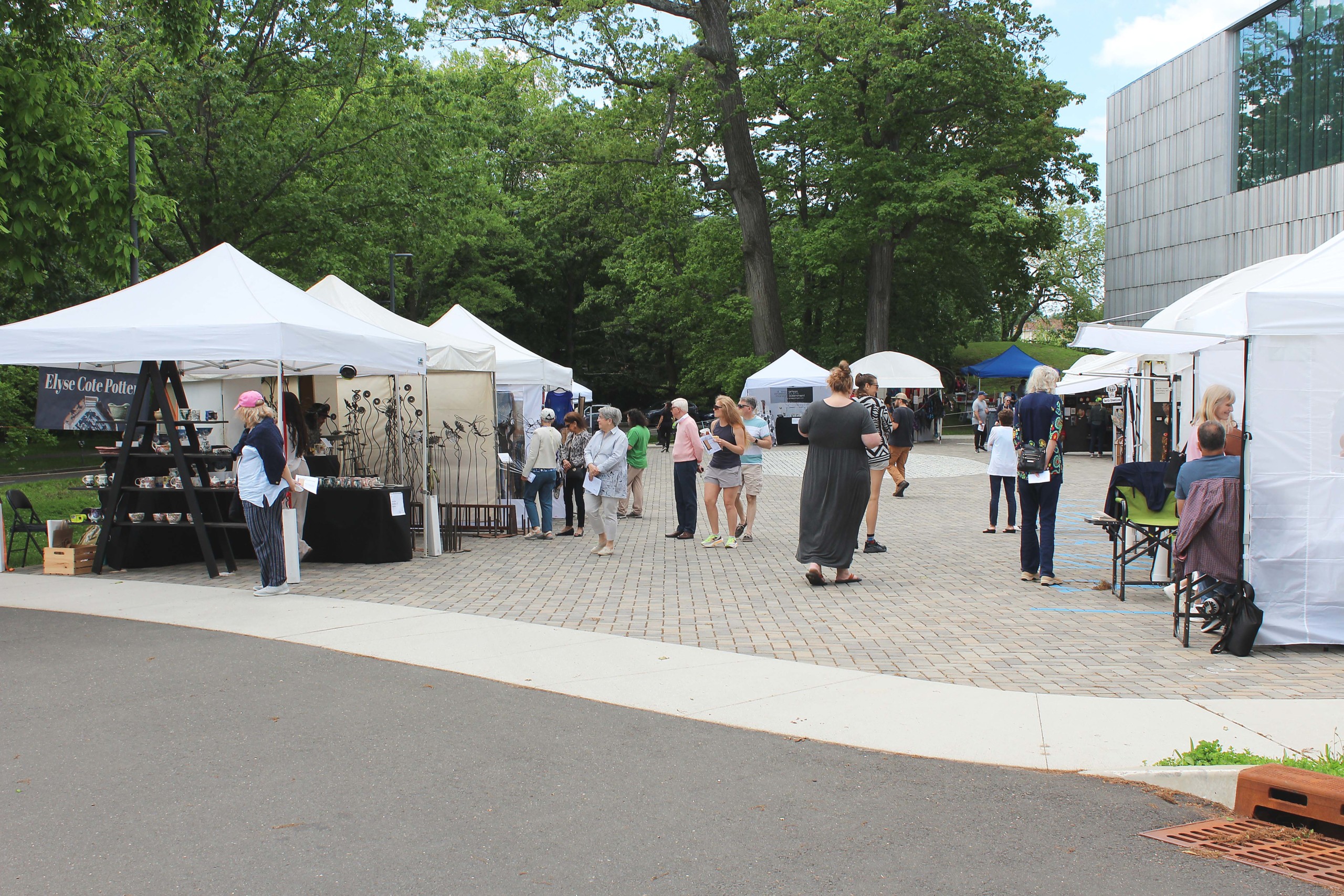
Around an hour and a half into the morning, the Sunday crowd continued to grow, with many shoppers stopping to chat with artisans at length about their work.
Review & Onsite Photos by Kiersten Busch
GREENWICH, CONN. — It was all sun and smiles on the morning of May 18, when Antiques and The Arts Weekly arrived at the Bruce Museum for its 40th Annual Outdoor Crafts Festival. Spanning two days — this year, May 17-18 — the festival is a highly anticipated event which brings together more than 50 contemporary artisans specializing in various handmade crafts, including jewelry, fiber arts, glass, furniture, pottery and more.
Alongside craft demonstrations and food courtesy of local gourmet food store and caterer, Aux Délices, this year’s festival also featured a special appearance by Moses Ros, the Bruce’s current artist-in-residence.
Following a rainy start to the fun on Saturday, artisans’ attitudes were much more positive at the sight of the calm, sunny conditions at the beginning of the festival on Sunday; weather that reminded New Englanders that, despite the long and tedious winter, summer is, in fact, on its way.
A few new faces were present at the festival this year, including wood carver Gilbert Carey, who traveled all the way from Milton, Penn. “It’s a good atmosphere, especially for a reasonably small show,” he reported when asked about how things had been going so far. Carey has been carving for 29 years, starting at a very young age because his oldest brother was already invested in the trade. “I grew up by the beach, which is why my carvings focus on marine stuff; that’s why I do it,” he said of the carved sea life — humpback whales, schools of fish, herons, sea turtles and more — that hung on the walls of his booth. Depending on the detail, his pieces can take around eight to nine hours to create and are primarily carved from walnut, English walnut, cherry, poplar and oak woods.
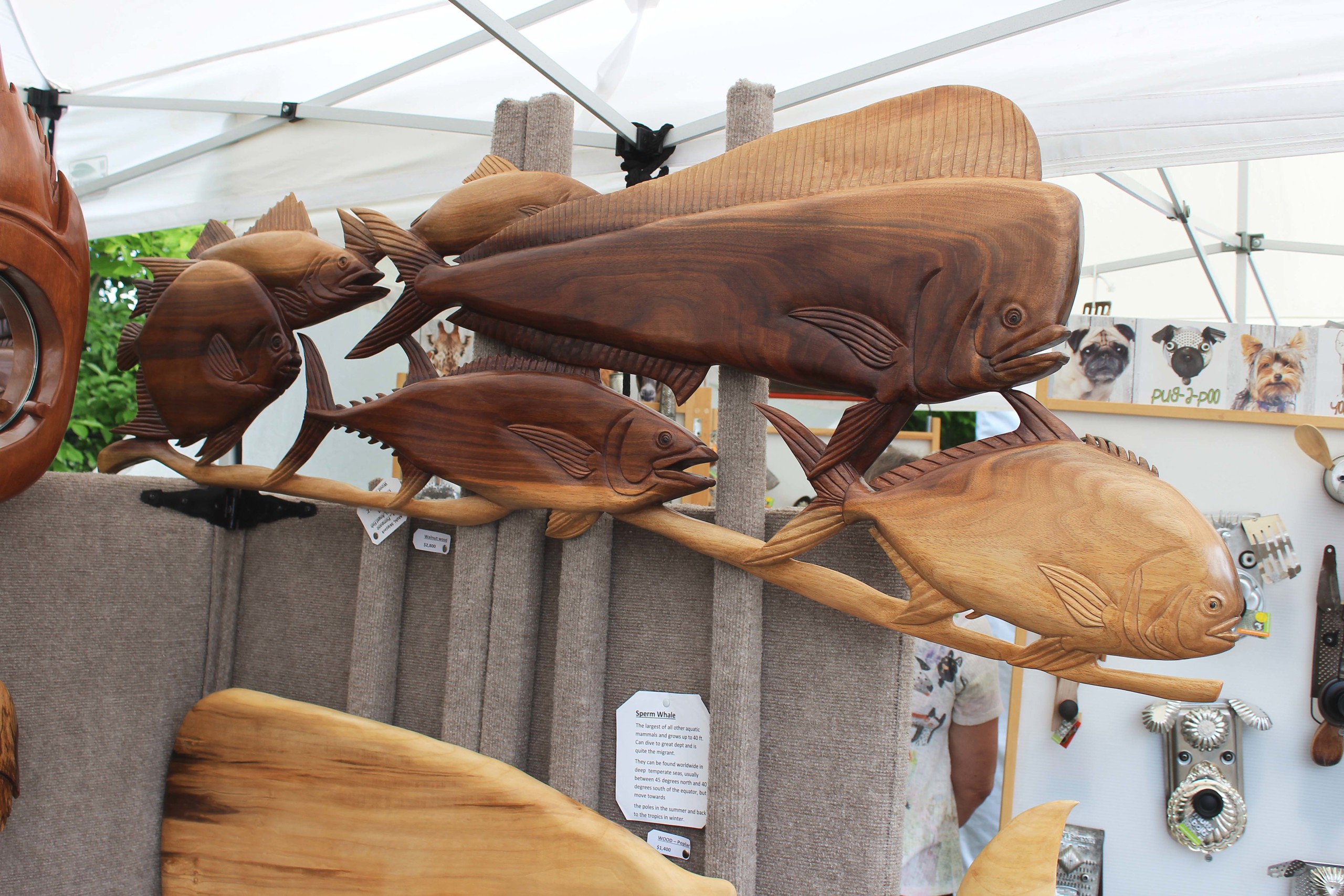
It was Milton, Penn.-based artisan Gilbert Carey’s first time at the Crafts Festival, where he brought an array of marine wildlife carvings made from a mix of walnut, cherry, poplar and oak woods, including this walnut school of fish.
Fresh off of their appearance at the New Haven Night Market on May 16 was another newcomer, Bright Raven Studio, headed by Gabriela Margarita De Jesus. The New Haven, Conn.-based artisan specializes in small-batch ceramics and candles which are usually a creative collaboration between De Jesus and her partner, who does most of the wheel throwing. De Jesus herself decorates using the sgraffito technique, scratching in freehand botanical designs, making each piece of pottery completely unique.
“The show overall… was a good show for me. I hope to do it again next year. The vendors were very nice. The people were nice that came through my tent and the museum is fantastic,” said first-timer Layne Manginelli. Wallingford, Conn.-based Manginelli, who participated under his business name Justin Mang Woodworx, was a woodworker making furniture and cutting boards for 25 years, and is now a “woodturner,” meaning, “I take a piece of wood and turn it into something, whatever my inspiration feels,” he explained. Manginelli switched paths 14 years ago, when he had the desire to make a bowl, but didn’t quite know how. Now, he makes plenty of bowls, along with his signature ornaments. “[The ornaments] are what makes me stand out from everyone else,” Manginelli emphasized, as he showed us a few examples, all made with multiple different kinds of wood. “It takes five weeks for me to produce one, and they weigh less than an ounce. I use both exotic and domestic lumber.”
Neal Drobnis, owner of Caste Glass in North Scituate, R.I., reported after the show: “The weekend was good. The location was great, but traffic was light.” Drobnis made up for the light traffic with his enthusiasm; “I try to have fun with it,” he said about his glass blowing, which he classifies as inspired by the Swedish school of glass blowing. “There’s lots of colors. It’s about using the least amount of lines for the best effect.” Drobnis’ subject of choice is birds, but that wasn’t always the case. “Glass is an expressionist medium,” he explained, “it’s capturing a moment in time. This moment is actually my evolution from egg to bird — I started with baubles, but now I’ve been doing birds for seven to eight years.” His favorite birds were a pair mounted on a small slab of stone, which were colored in a mottled blend of white, blues and greens.
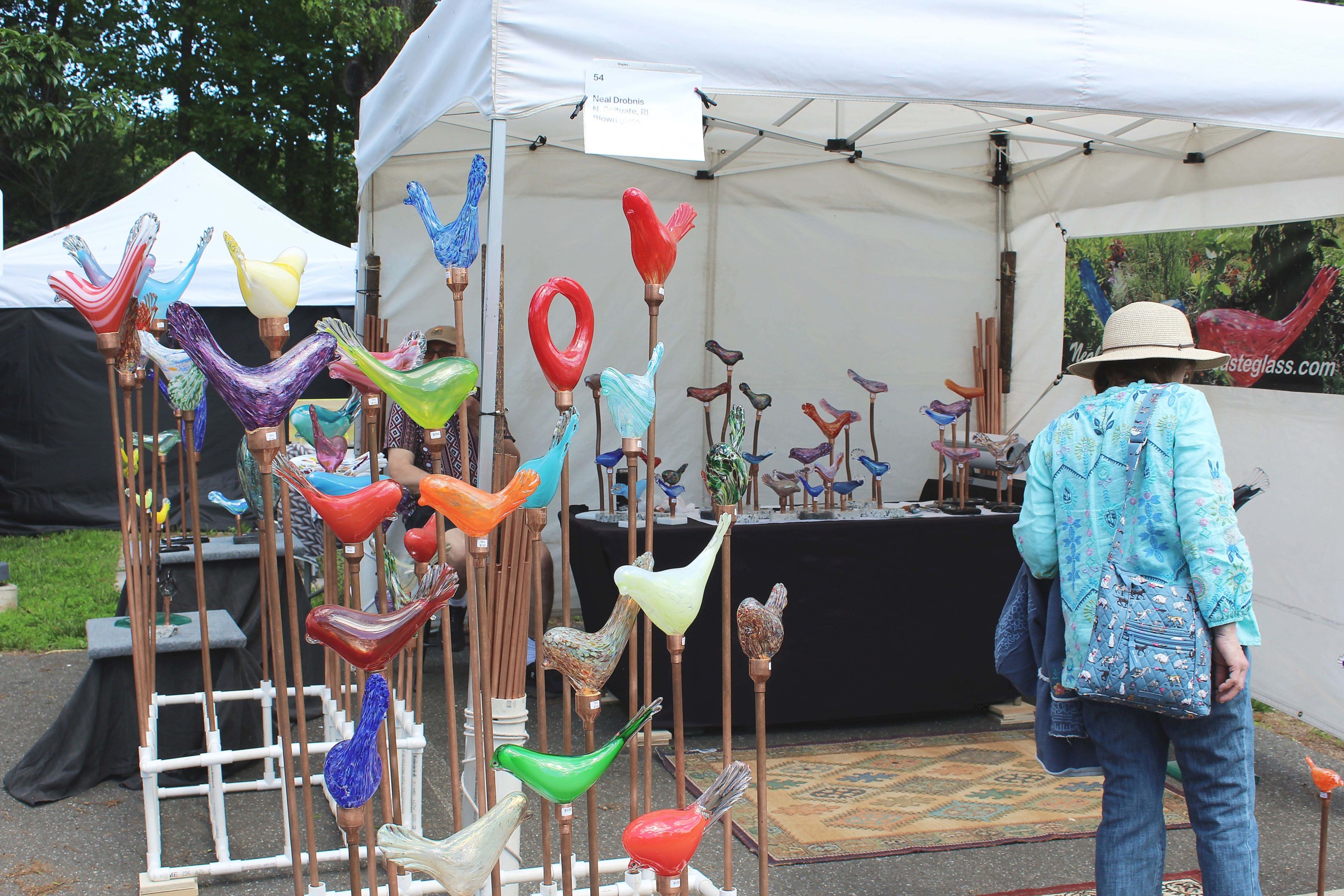
The colorful blown glass birds decorating the booth of Neal Drobnis are made in the style of the Swedish School of glass blowing, where “it’s all about simplicity of form,” he shared. Caste Glass, North Scituate, R.I.
James Takaki’s booth was the first we stopped at for the day, and he reported that Saturday, although rainy, was “a nice day, and the attendance was good.” A self-taught artist for around 30 years, Takaki — whose Brattleboro, Vt.-based business is named Iron Arts — makes nature-themed metal garden sculptures, including birds, bees, dragonflies and various flowers, all of which he had on offer. “I’m always making things,” he said. “Things for your garden, whimsical ornaments, things like that.” For Takaki, every piece of his work is special and one of a kind. Instead of centering himself in a discussion of what his favorite sculpture was, he chose to focus on his customers’ desires. “When you meet customers, you start to know how they experience things, and understand what’s special to them,” Takaki concluded. By the time we were wrapping up for the day, we saw a happy customer leaving the festival with one of Takaki’s sculptures in tow.
While there was jewelry abound at the festival, Virginia Stevens’ caught this reporter’s eye quite early on. The owner of Virginia Stevens Design, based in Cranston, R.I., Stevens has been exhibiting at the festival for around six or seven years. Despite the slowness on the first day due to the weather, Stevens had nothing but good things to say about her time thus far. “It was beautiful,” she gushed about the opening day as she unpacked more of her sterling silver jewelry, placing it in the glass cases that separated us. “There were lots of appreciative people. It’s a gorgeous show, and it’s lovely to share a space with such talented people.” Before opening her own business making sterling silver jewelry, Stevens was a designer in the jewelry industry. She’s operated Virginia Stevens Designs for about 25 years, and is inspired by “architecture, modern design and archeology. They combine in my work somehow, which is done in sterling, with some leafing and occasionally gold.” While showing us a necklace made with seven circular pieces of silver that she was particularly fond of, Stevens also explained that her pieces take anywhere from 20 minutes to a couple hours to complete; “just depending on the size.”

This necklace was a favorite of Virginia Stevens, who is inspired by a mix of architecture, modern design and archaeology to create her sterling jewelry. Virginia Stevens Designs, Cranston, R.I.
Handmade bags were also trendy, with artisans such as Carol Hunts Stanland from Old Lyme, Conn., hopping on the tote bag trend with her block printed fiber tote bags that attracted plenty of attention from attendees. Another Carol, Carol Hearty, who traveled all the way from Beacon, N.Y., also offered handmade bags, these ones with a twist. Her leather “flat pack” bags were designed to fit conveniently into a suitcase for traveling and zip up to form the shape of a regular bag when you want to wear them out. “I’ve been making them since the 80s,” she explained. “They’re very seasonal. Right now, for summer, I have bright colors and navy. They’re all hand-painted leather, and no two bags are alike. I’ve got a studio full of bits and bobs, which I pull together to make the bags.” Hearty’s bags come in various shapes, including a triangle, a flower and butterfly wings, which can fold into a shoulder bag. “I did this show years ago, then I switched to only doing shows in Florida. But it’s local, and it has good organization, so I’m back,” Hearty shared happily.
Kathleen Scranton from Coventry, Conn., was also in the bag business, hand making book cover bags by sourcing used books and turning their covers into wearable art. Selling under the name BeeZ, Scranton has been coming to the festival for the last 15 years. “People like books here,” she said with a smile. “They appreciate they’re getting the book back, but in a different way.” She was happy with her performance on opening day and reported that she “still sold,” despite the weather.
The origins of Scranton’s craft date back to 2009, during the stock market crash. “I was a marketing director in corporate America back then, and when the crash happened, because I was a 59-year-old woman who made a lot of money, they fired me,” she shared. “I went to work at a library to rediscover myself and saw the librarian throwing away an old copy of Black Beauty. When I asked her why, she told me, ‘No one reads the old books.’ I bought it off her for five dollars and decided to do something with it. Because of my corporate experience, I knew women would buy shoes and purses during a recession. And, well, you can’t really make shoes out of a book, now, can you?” The rest, they say, is history. She has now sold more than 6,000 of her bags and works with her husband — “my book boy,” she joked — and son. After all these years, the Black Beauty bag is still her favorite. While she did not have that one on hand, she proudly showed us bags made from Marguerite Henry’s King of the Wind and Sea Star: Orphan of Chincoteague.
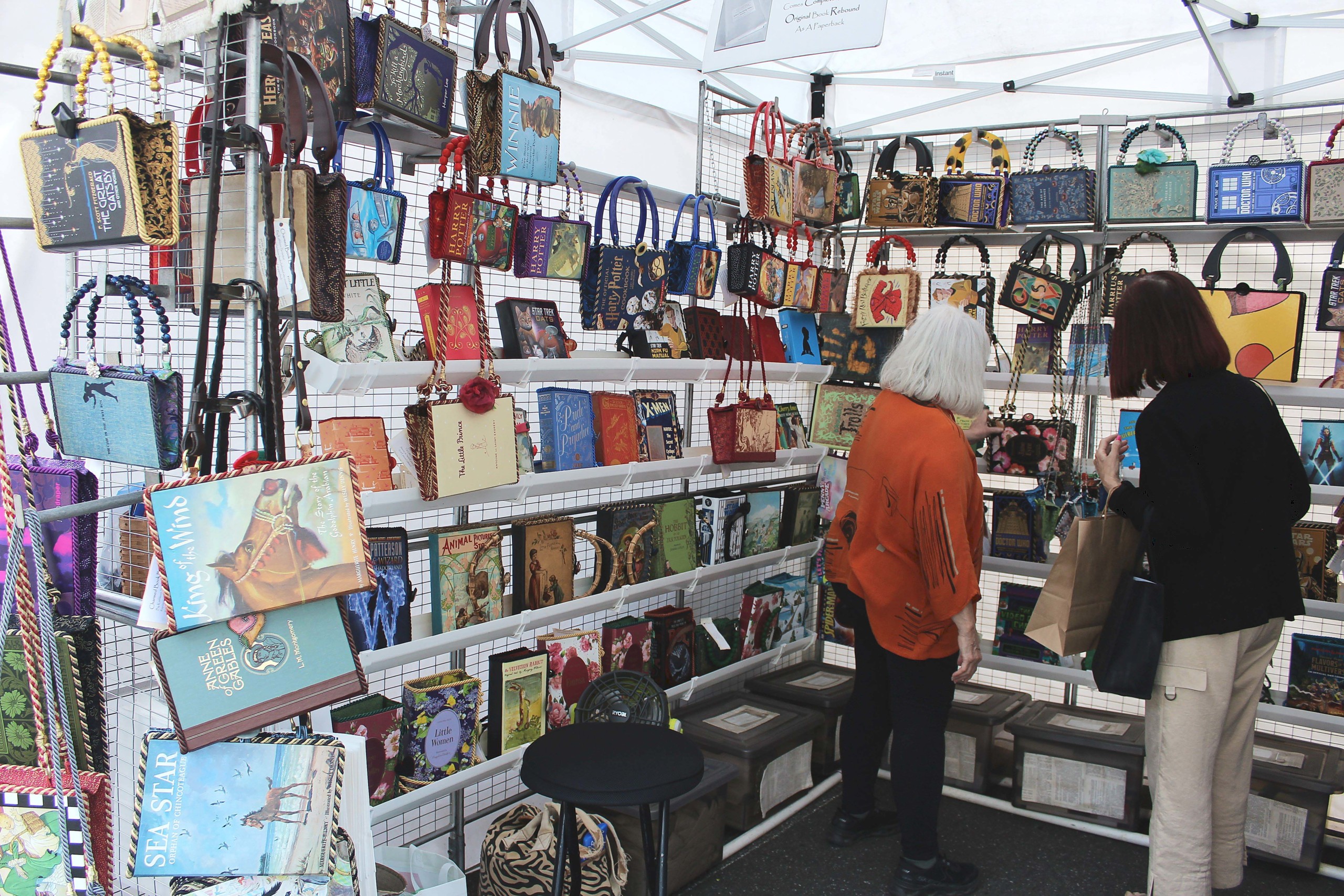
Kathleen Scranton (left), the “Queen Bee” of BeeZ, Coventry, Conn., guides a customer through her booth, where hundreds of her book cover bags were hung with care. “I have lots of banned books!” she said enthusiastically.
After the festival’s conclusion, Scranton took the time to share some of her thoughts with us: “The book gods must have aligned this year. Despite the low attendance, we had a good show. This year, I knew it would be different, as all of us artists feel there is a ripple in the economic air that we might have to endure this year. The crowds were way down, and yet, we made a profit, saved another dozen or two of old books from the landfill.
As an artist, we all work hard to create our own visionary art, whether it be book purses or fiber paintings or rusty screens or jewelry. This year, even with the crowds as scarce as they were, people still looked for their favorite book. I received a few custom orders about their favorite books, some texted relatives to find out what were their favorite books and even though some could not afford one this time around, they loved the idea that someone was saving all these books from the landfill and took a business bookmark. I will apply again next year. It feels good to know that I am making a small dent in keeping these books alive and becoming a wearable work of art.”
The date for next year’s Outdoor Crafts Festival has not yet been announced. For information, www.brucemuseum.org or 203-869-0376.
